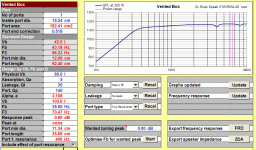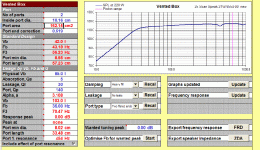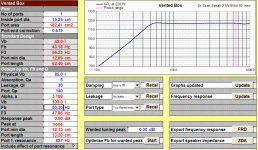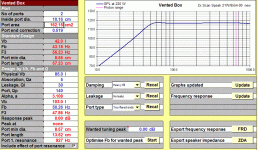I'm using Unibox to try to calculate port tube size for dual Scanspeak 8554 drivers. If I use a single port tube in my 3 cu foot box (sorry already bought and mounted drivers there) it tells me I need a 5" or 6" diameter port tube. Is there any benefit to using dual port tubes? Will one sound any different than the other. I was planning on using dual flared Parts express tubes.
Should I put the port tube close to the woofer or far away?
How do you decide what frequency to tune for? (for now I have chosen 40hz since the bass guitar is the lowest instrument I commonly listen to)
Should I put the port tube close to the woofer or far away?
How do you decide what frequency to tune for? (for now I have chosen 40hz since the bass guitar is the lowest instrument I commonly listen to)
Here are a couple of links to port length tuners -
Linear Team (Makers of WinISD speaker design and modeling software)
http://www.linearteam.dk/default.aspx?pageid=ventcalculator
This will only do round ports but you can do more than one port. If you don't know the Vent Mach/Acoustic Power number, don't worry about it, it will calculate without it. Make sure the units of measurement match the numbers you are entering.
Steve Ekblad's Free Audio Software-
http://www.audiogrid.com/audio/
Scroll down to the port length calculator (Port Designer). This calculator will do single or multiple rectangular or circular ports.
You mention that you've determined your Port should be 5" or 6" in diameter, but you don't say how deep (or long) it should be.
Also, consider making your port tubes out of round PVC plumbing pipe. The Pipe rating (4", 3", 2", 1.5") is inside diameter; generally ridged and inexpensive.
As far as the frequency, you should start with the resonance frequency of your speaker. In a sense, a speaker box is an Anti-resonant Chamber, it counters the resonance of the speaker itself. There are three schools of thought on the matter; either tune cabinet right on the resonance frequency of the woofer, just above it, or just below it. Each has its own pluses and minuses. Generally, you are tuning the cabinet to match the speaker.
Though I can't say for a fact, I'm under the impression that making the cabinet resonate above the woofer will cause a peak in low frequency response and a very fast drop off, tuning at the resonance of the woofer causes a smooth even roll off of low frequencies, and tuning below the woofer will cause an earlier but slower drop off. Can anyone confirm whether this is correct?
Hope that helps.
Steve/BlueWizard
Linear Team (Makers of WinISD speaker design and modeling software)
http://www.linearteam.dk/default.aspx?pageid=ventcalculator
This will only do round ports but you can do more than one port. If you don't know the Vent Mach/Acoustic Power number, don't worry about it, it will calculate without it. Make sure the units of measurement match the numbers you are entering.
Steve Ekblad's Free Audio Software-
http://www.audiogrid.com/audio/
Scroll down to the port length calculator (Port Designer). This calculator will do single or multiple rectangular or circular ports.
You mention that you've determined your Port should be 5" or 6" in diameter, but you don't say how deep (or long) it should be.
Also, consider making your port tubes out of round PVC plumbing pipe. The Pipe rating (4", 3", 2", 1.5") is inside diameter; generally ridged and inexpensive.
As far as the frequency, you should start with the resonance frequency of your speaker. In a sense, a speaker box is an Anti-resonant Chamber, it counters the resonance of the speaker itself. There are three schools of thought on the matter; either tune cabinet right on the resonance frequency of the woofer, just above it, or just below it. Each has its own pluses and minuses. Generally, you are tuning the cabinet to match the speaker.
Though I can't say for a fact, I'm under the impression that making the cabinet resonate above the woofer will cause a peak in low frequency response and a very fast drop off, tuning at the resonance of the woofer causes a smooth even roll off of low frequencies, and tuning below the woofer will cause an earlier but slower drop off. Can anyone confirm whether this is correct?
Hope that helps.
Steve/BlueWizard
BlueWizard said:
Though I can't say for a fact, I'm under the impression that making the cabinet resonate above the woofer will cause a peak in low frequency response and a very fast drop off, tuning at the resonance of the woofer causes a smooth even roll off of low frequencies, and tuning below the woofer will cause an earlier but slower drop off. Can anyone confirm whether this is correct?
You mean like this?
Upper to lower curves: Qts=0.6, 0.38 and 0.2
Red to green curves: fp=45, 35 and 25 Hz
An externally hosted image should be here but it was not working when we last tested it.
As for the question if double vents are better than a single one:
If we are comparing vent with the same total cross-sectional area, ie the summed area of the two vents is the same as the area of the one vent, there might be a slight advantage towards the double vents.
The reason for this is that for the same airspeed (which is different from volume flow, nb), it is harder to develop turbulence inside a narrow tube.
However, using rediculously narrow tubes, like 1 cm diameter, increases the flow resistance, and that is typically bad.
It appears I can use two port tubes 10" long - 4" diameter to achieve the same thing that one 9.5" long - 6" diameter tube can do.
Should I take the port resonance (as modeled by Unibox) very seriously? It shows that I could possibly have port resonance varying from 400hz to 800hz only 12db down from the port's peak at say 40hz.
Should I measure port tube length from the tips of the flare? I am using a dual flared Precision Port from Parts Express.
It appears in modeling that lowering the port tuning can increase resonance. This is probably due to the longer port length.
Should I take the port resonance (as modeled by Unibox) very seriously? It shows that I could possibly have port resonance varying from 400hz to 800hz only 12db down from the port's peak at say 40hz.
Should I measure port tube length from the tips of the flare? I am using a dual flared Precision Port from Parts Express.
It appears in modeling that lowering the port tuning can increase resonance. This is probably due to the longer port length.
Linearteam's WINisd pro does both round and rectangular ports in any quantity.BlueWizard said:Linear Team (Makers of WinISD speaker design and modeling software)
http://www.linearteam.dk/default.aspx?pageid=ventcalculator
This will only do round ports but you can do more than one port.
Svante's middle green curve is similar to my sub.
Fs=31.6Hz, Fv=23Hz, Qts=0.314 resulting in a downward slope of 3db/octave from 100Hz to 25Hz and then drops off at a faster rate, achieves 110db @ 20Hz from 300W at 5mm xmax limit. Sounds nice without exaggerating male voice.
Svante said:
However, using rediculously narrow tubes, like 1 cm diameter, increases the flow resistance, and that is typically bad.
I was under the impression that resistance to the flow is an essential part of the system. Otherwise you end up with 2 masses (the speaker cone and the mass of the air), two springs (the air spring and the spider suspension), but only one shock absorber as past of the physical model, which is incorporated in the spider and surround.
If there's insufficient resistance against the velocity of the air flow, you get a peak in the port output.
CeramicMan said:
I was under the impression that resistance to the flow is an essential part of the system. Otherwise you end up with 2 masses (the speaker cone and the mass of the air), two springs (the air spring and the spider suspension), but only one shock absorber as past of the physical model, which is incorporated in the spider and surround.
If there's insufficient resistance against the velocity of the air flow, you get a peak in the port output.
AndrewT said:Did anyone try the straws in the port experiment?
Well, maybe I was a bit cathergorical in my statement that resistance is bad, but...
Resistance is not necessary in a port. There are resistive losses on other places in the system that will eliminate sharp peaks in the response, like the systems I simulated above. None of these have a resistance in the port worth considering.
Resistance in the port has the effect of lowering the response at the port resonance. The volume of the box, on the other hand, has the effect of increasing the level at the port resonance. So, for a given response curve, there is a tradeoff between port resistance and box volume. If there is a resistance in the port (or in the box for that matter) the box volume has to be larger for identical response curves. That is why I said that resistance is bad, it will increase the demand on the box size.
That is for small signal behaviour.
For large signal behaviour there is this effect of less turbulence inside the tube if the tube is narrow (at a given airspeed). So this effects has to balanced against the resistance effect, and I might have been too cathegorical in saying that tubes of 1 cm diameter is rediculously narrow, but the limit where flow resistance starts to dominate too much lies somewhere there. Anyway, the increased flow resistance can be considered in the design (by increasing the box volume) so I suppose it is ok. An increased box volume has other benefits as well with regards to tube dimensions and overload, so it might be a good thing if the space is not a problem.
In the end, the designer of a loudspeaker system will have to balance all these and other things against one another, and that is one of the most interesting things in loudspeaker design IMO. To find a good balance and not optimize for one parameter alone.
Svante,
Is it safe to assume that the Blue (35hz) graphs are very close to the resonance frequency of your modeled loudspeaker?
And that the center graph (Q=0.38) represent the generally best and closest possible tuning regardless of whether you tune on, above, or below the speaker resonance?
I would think that 35 hz Q=0.38, the blue of the center graph, is what most people would consider ideal or 'flat' response?
Finally, thanks for the graphs, that is a great help to me, and thank for your help in my other thread.
Steve/BlueWizard
Is it safe to assume that the Blue (35hz) graphs are very close to the resonance frequency of your modeled loudspeaker?
And that the center graph (Q=0.38) represent the generally best and closest possible tuning regardless of whether you tune on, above, or below the speaker resonance?
I would think that 35 hz Q=0.38, the blue of the center graph, is what most people would consider ideal or 'flat' response?
Finally, thanks for the graphs, that is a great help to me, and thank for your help in my other thread.
Steve/BlueWizard
BlueWizard said:Svante,
Is it safe to assume that the Blue (35hz) graphs are very close to the resonance frequency of your modeled loudspeaker?
And that the center graph (Q=0.38) represent the generally best and closest possible tuning regardless of whether you tune on, above, or below the speaker resonance?
I would think that 35 hz Q=0.38, the blue of the center graph, is what most people would consider ideal or 'flat' response?
Yes, the mid blue graph is a classical butterworth design. If listening takes place in a truely anechoic chamber, that is optimal.
If, on the other hand, listening takes place in an ordinary room, there will be a bass lift, and therefore a curve similar to the mid green could be preferred.
This is if we would have had recordings straight from the microphone to the data stream of the CD.
However, for ages the Butterworth solution has been considered "correct", also in recording studios. This has resulted in numerous recordings that have been mixed with Butterworth aligned speakers, and adjusted tonally for those.
So, the answer to what is optimal is not all that easy. Actually typical CD recordings are far from standardised with respect to this. The movie industry has a much better situation, IMO.
Daveis said:It appears I can use two port tubes 10" long - 4" diameter to achieve the same thing that one 9.5" long - 6" diameter tube can do.
Should I take the port resonance (as modeled by Unibox) very seriously(is it audible in other words)? It shows that I could possibly have port resonance varying from 400hz to 800hz only 12db down from the port's peak at say 40hz.
Should I measure port tube length from the tips of the flare? I am using a dual flared Precision Port from Parts Express.
No one has an idea about these questions?
can you post your Unibox graphs?
Also, there is a port length calculator on http://www.psp-inc.com/ website that will do the conversion for you...
Also, there is a port length calculator on http://www.psp-inc.com/ website that will do the conversion for you...
Daveis said:Should I take the port resonance (as modeled by Unibox) very seriously? It shows that I could possibly have port resonance varying from 400hz to 800hz only 12db down from the port's peak at say 40hz.
It appears in modeling that lowering the port tuning can increase resonance. This is probably due to the longer port length.
Port pipe resonances are a reality and yes they should be taken seriously. However, there are great difficulties in modelling their amplitude correctly, since it depends largely on the placement of the port in the box. Port placement is rarely considered in simulators (I don't know about unibox, though).
And yes, the longer pipe that is used, the lower frequency the pipe resonances will occur, and they will be stronger.
Also, the tuning of the port is also somewhat hard to model exactly, partly due to the largely unknown amount of isothermalization from the box stuffing. It is often a good idea to verify the port tuning by measurement and adjust the port length until a close enough tuning is achieved.
Another thing to do is change the max power and make sure that the nominal power rating is reasonable given x_max . I do this by changing the nominal power on the first worksheet until the red line on the first graph on the vented sub sheet (SPL produced by driver at x_max) is tangent to the black "SPL produced by driver line". Then I look at the air speed graphs. I repeat this for x_max / 2 and x_sus to get an idea of power handling and the port behavior under these conditions.
Another question would be how steep of a crossover are you considering?
Another question would be how steep of a crossover are you considering?
luvdunhill said:
Another question would be how steep of a crossover are you considering?
I am using 24db/octave at 800hz. I notice that port resonance in all cases I've considered is under 800hz and will be competing with the bass driver. I suspect this is the norm.
I've ordered four 4" diameter flared ports and will get to installing them next weekend.
This has been my first attempt at a ported speaker. Originally, I had been using two 12" Dayton Reference subwoofers crossed in at 80hz. I am starting to wonder if the sound of vented bass is more coherent than using additional drivers.
For instance, if every speaker came equipped with a sealed box 15" subwoofer would people be porting their 8" woofers?
- Status
- This old topic is closed. If you want to reopen this topic, contact a moderator using the "Report Post" button.
- Home
- Loudspeakers
- Multi-Way
- Single Port Vent Better than Dual Port?



